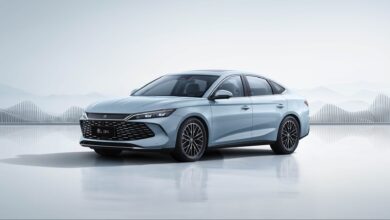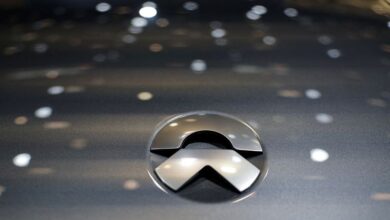Electric Vehicles Accelerate Toward 50% Of Global Sales

Clean energy and Mark Twain aren’t usually connected, but paraphrasing his famous quote is apt: The reports of electric vehicle sales’ death are greatly exaggerated.
Salesman showing new electric car to multiracial couple at showroom. Female sales manager holding … [+]
Data from The International Energy Agency’s Global EV Outlook 2024 makes vibes-based reporting on the demise of EV sales look silly – global EV sales could hit 17 million in 2024, meaning more than one in five cars sold worldwide will be electric.
Surging demand for clean, cheap EVs across the rest of this decade will completely change the global auto industry. By 2035, IEA projects 50% of all cars sold globally will be EVs, cutting oil demand between 6-10 million barrels per day, equivalent to the current amount used for road transportation in the U.S.
The price differential between EVs and internal combustion engines running on fossil fuels has narrowed so fast that upfront sales prices are barely different. With cheap electricity displacing expensive oil costs, drivers can save big by driving electric.
This is huge news for cutting consumer costs, creating new jobs and investment, and cleaning up our air.
Everyone, everywhere wants to save money and breathe cleaner air. Soon everyone, everywhere will soon have the choice to make their next car a clean, cheap EV.
Electric Vehicle Sales Accelerating In All Major Markets
IEA’s annual Global EV Outlook identifies and assesses recent developments in global electric mobility. And IEA is considered the world’s leading authority on all energy trends, meaning this forecast isn’t hype – it’s data driven.
Recent news reports have advertised a decline in sales to herald the end of the EV revolution, but the actual numbers couldn’t be further from those vibes-based headlines in the world’s three biggest auto markets.
This year EV sales in China, the world’s biggest auto market, are projected to hit 10 million vehicles, roughly 45% of all car sales in that country. In the United States, the world’s second largest auto market, EV sales are forecast to rise 20% compared to 2023, hitting roughly 11% of all new car sales. And in Europe, the world’s third largest auto market, EV sales could rise 10%, composing 25% of total sales.
IEA (2024), Quarterly electric car sales by region, 2021-2024, IEA, Paris … [+]
New car sales eventually turn over entire fleets, and the IEA projects that by 2030 EVs will compose 33% of all cars on the road in China while 20% of all cars on the road in the U.S. and EU will be electric.
Smart Electric Vehicle Policy Breaks Down Barriers To Ownership
The key to these sales is a combination of smart policy and maturation across the entire EV industry. The IEA notes policies in the big three auto markets – China’s 14th Five-Year Plan, the U.S. Inflation reduction Act, and the EU’s Net Zero Industry Act – have given automakers the policy certainty to make long-term investments, which cuts costs while adding supply.
More than 20 automakers across the world representing 90% of global car sales have set electrification targets, and in 2022-2023, EV and battery manufacturing investments totaled $500 billion.
EV costs are falling as technology improves and manufacturing expands, with most EVs sold in China being cheaper than internal-combustion engines and cost parity expected by 2030 in all other major markets outside that country.
Even when upfront costs of EVs aren’t cheaper than gas-powered cars, EVs are often still cheaper to own – leasing an EV is the cheapest way to purchase a new car in the U.S. and charging an EV is cheaper than filling up an internal-combustion engine sedan, SUV, or truck in every American state.
Leasing an electric vehicle is up to $6,000 cheaper per year and buying or leasing an equivalent … [+]
Global battery recycling capacity reached 300 gigawatt-hours in 2023, and could exceed 1,500 GWh in 2030, more than triple the battery supply that could potentially be recycled that year as EVs reach the end of their life.
And global public charger installations rose 40% in 2023 compared to 2022, with fast-charger station additions outpacing slow-charge stations.
So, the four major barriers to EV ownership – availability, cost, charging, and waste – are all well on their way to being overcome. No wonder the IEA is so bullish on EVs future.
In The U.S., The Electric Vehicle Sales Vibes Are Actually Great
These trends are all showing up in the U.S., no matter what the headlines read.
While Tesla sales may have slipped, other brands have increased sales, partially offsetting the decline. For instance, Ford’s EV year-to-date sales have nearly doubled, total sales across the country rose in Q1 2024, and nationwide EV sales have grown every quarter since 2021.
Energy Innovation modeling shows that post-Inflation Reduction Act EV sales are actually at the highest end of initial estimates, on track to hit transportation sector emissions reduction targets. Perhaps that’s due to average transaction prices for EVs in the U.S. falling to just under $51,000 in December 2023, closing the cost parity gap with gas-powered cars to just $2,000.
Federal policy is also supercharging the rest of the EV ecosystem. Since the Inflation Reduction Act’s signing, automakers and battery manufacturers have announced nearly $88 billion in new EV and battery factories.
Electric vehicle and battery manufacturing investment announcements made since the Inflation … [+]
And the U.S. is now home to 8,200 public fast-charging stations, or one fast charger for every 15 gas stations. That number is sure to rise thanks to $7.5 billion in EV charging funds allocated by the Infrastructure Investment and Jobs Act to build a national network of at least 500,000 public chargers by 2030 – all part of the Biden administration’s clean energy strategy.
Electric Vehicles Cuts Costs And Cleans The Air
Big Oil CEOs have taken advantage of volatile energy prices caused by conflicts in Ukraine and the Middle East to cause pain at the pump, netting more than $238 billion in profits in 2021 and $451 billion in profits in 2022.
Evidence released by the Federal Trade Commission shows high oil prices from 2021-2023 was due to collusion among oil companies, costing the average American family of four between $2,000-$4,000 in 2021, between 15%-30% of all inflationary cost increases that year.
It’s no surprise consumers are choosing EVs – driving electric is the most direct way to personally crack down on price gouging by oil companies and get off the fossil fuel rollercoaster, because electricity prices are lower in comparison and have remained stable on time.
Driving an EV is also an easy way to breathe cleaner air. Tailpipe pollution from internal combustion engines are concentrated around major roads and harm people’s health through asthma, cardiovascular disease, impaired lung development in children, and premature death.
So don’t trust the vibes when it comes to EV sales. Your wallet and your lungs will thank you later.



